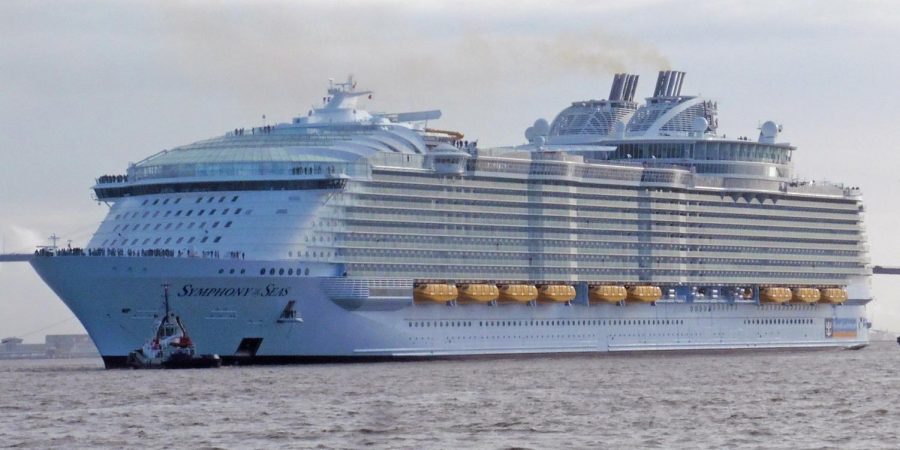Going cruising? These aren’t your grandparents’ cruise ships any longer; they’re more like floating amusement parks
The Symphony of the Seas is the latest in the super-sized cruise ships. It can accommodate over 6,500 passengers.
As the world has changed in the past century, so has the cruise industry. Passenger ships that were once seen as modern-day marvels, would today be chuckled at for their small size, lack of modern, technological features and engaging entertainment options for younger passengers.
But before delving into the differences between past and present ships, it is vital to uncover a bit about cruise ship history.
Prior to the World Wars, ships made transatlantic crossings to and from New York and Southampton, England. However, during the wars, many passenger liners were used to transport troops overseas and were not offering sailings for those seeking voyages across the Atlantic.
After the wars, and due to the invention of passenger jets, ocean liners became less popular with Americans and Europeans. The companies that had operated transatlantic ocean liners which carried passengers and cargo between the U.S. and Europe found that they could no longer compete with the speed and relative affordability of modern jet travel.
Travelers no longer desired a seven-day journey from New York to London when they could take a jet that could travel the same distance in a few hours. In order to encourage more passengers, former ocean liners were converted into “pleasure vessels” that would sail warm, tropical climates such as the Caribbean. Hence, the modern definition of a “cruise” was born in the mid-1960s.
The Different Clientele
The clientele supporting the cruise industry went through a massive turning point with debut in 1977 of the ABC television show The Love Boat. The immensely popular show followed different celebrity guest stars and constant crew/cast members as they experienced love and laughter aboard the Pacific Princess. Due to the show’s popularity, the American interpretation of cruises was completely transformed: no longer seen as a remnant from the 1930s meant only for those of high-society, cruising became more of a vacation option for the middle class.
“People could see these big movie stars like Lana Turner or Van Johnson portray ordinary people in very ordinary situations,” remarks Michael L. Grace, a cruise industry historian at Cruising the Past and former scriptwriter for the TV series. Therefore, this ushered in a whole new generation of cruisers, one that appealed to all different classes, rather than just the wealthy.
On another note, a common misconception (even today) is that cruises tend to be more for the elderly. However, that is certainly not the case, with statistics pointing to more young adults and teenagers going on cruises. In fact, according to the Florida-Caribbean Cruise Association, two-thirds of Generation Y/Millennials say that cruising is their favorite vacation, and this preference is even more notable among Generation X, at 71 percent.
The trend of the past seems to be surprisingly etching itself into the future. Preceding the World Wars, passenger liners used to be separated by class, with first class cabins and lounge/dining areas strikingly different compared to those of third-class. Recently, cruise lines such as MSC Cruises and Norwegian Cruise Line have been incorporating “ship-within-a-ship” experiences on their newer ships. For example, Norwegian offers the Haven, a separate part of the ship with only Haven guests; where passengers who are willing to pay the extra bucks for suite cabins, share a Haven pool and sundeck, concierge, and dining room, as well as receive priority embarkation on and disembarkation off the ship. In other words, the modern cruise line definition of “first-class.”
Activities/ Entertainment
During the first half of the 1900s (before the advent of airplanes), cruise ships were more glamorous, with entertainment on classic cruise ships including ballroom dancing, shuffleboard, sun bathing, swimming in the pool, listening to live music, and participating in egg and spoon races. Some guests even organized boxing matches!
In the 1960s, according to Alan Pirowskin, owner of Perry Travel, nightly entertainment was “poor by today’s standards,” as shows would consist of a singer, comedian, a band, and maybe a couple of dancers.
Today, cruise lines have expanded on providing quality entertainment and fun experiences and have transformed their ships into moving hotels and amusement centers. Many modern cruise ships now sport massive theaters, sports complexes, gyms, hot-tubs, slides, pools, casinos, wave-riding simulators, and ice skating rinks (for ice-skating shows). Some ships even have their own bumper cars, such as the Norwegian Encore. Additionally, in a revolutionary breakthrough in cruise ship entertainment, Carnival’s Mardi Gras will incorporate the first roller coaster at sea!
“I prefer cruises today as it is more than food, and there are endless possibilities of activities to do from race car driving to bumper cars and coming soon a roller coaster at sea,” admits Alan Taylor, Senior Corporate Sales Agent of TMC Travel Management & Cruises,who himself has been on over thirty cruises throughout his life. Without a doubt, cruising has certainly improved in the entertainment category.
More kid-friendly options
In the past, it was rare to see children on cruise ships, yet today it is the norm! How did this change? In the 1960s, some ships offered babysitting services for young children by having crew known as “houseboys” babysit babies and children when parents wanted to have a night to themselves. However, there was no designated children’s area.
The 1980s and 1990s saw cruising cast off its image as a vacation only for senior citizens and honeymooners; cruise lines such as Carnival, Norwegian and Royal Caribbean built larger ships with far more amenities than just a pool and shuffleboard court, by adding rock-climbing walls, multiple pools and hot-tubs, sports courts, and arcades.
In addition, cruise lines began to offer child and teen clubs where minors could engage in separate age-appropriate games and activities with other passengers their age. This had never existed before. Today, some modern and new ships now offer zip lines, laser tag, ice skating, obstacle courses, slides, escape rooms, and table tennis. Quite a contrast from the days of practically no children.
Food/Drinks
Of course the food on cruise ships has always been good, but it has become even more diverse in the past few decades. For example, the endless buffets found on cruise ships today was not an integral part of cruise ship designs of the past. In fact, most ships didn’t have a buffet; instead, there was one grand dining room which would be a source of food for breakfast, lunch, and dinner.
Back in those days, the dining room would be a source of entertainment in itself: typically dinners would last from two to three hours. According to Pirowskin, the norm of the food served in the 1960s was more “elegant” and “expensive” than the food characteristically served today on cruise ships, with typical meals consisting of roast beef, filet minion, lobster tail, and other costly items.
Another notable change is that ships today have specialty dining options that come at extra costs. These restaurants have an up-charge, but are usually different themed restaurants such as Hibachi, seafood, Italian, and steakhouse. Bigger ships have an even larger variety of themed restaurants; for example, the Symphony of the Seas (the largest ship in the world) has a whopping twelve specialty restaurants which even include chain restaurants such as Starbucks and Johnny Rockets. In contrast, in the 1960s, all food was complimentary, as were alcoholic and non-alcoholic drinks. Today, passengers have to pay for beverages including beers, sodas, and wines.
Less Strict Dress Codes
Speaking of dining, another change that has occurred within the cruise industry is the enforcement of dress code policies onboard. In the past, boarding a cruise ship was something to dress up for – women would wear dresses, men would wear suits. But today, it is completely different. It is perfectly acceptable to board a cruise ship and walk around dressed casually in a T-shirt or tank top and shorts.
Also, eating at the main dining room for dinner was something to dress up for as well. Back in the 1960s and earlier, passengers would likely get refused entry into the dining room if they didn’t dress accordingly. If a gentleman forgot to wear a jacket and tie, some ships would have racks with jackets and ties for him to borrow for the evening.
Today, most cruise lines have a less strict attitude towards dress code in the dining room, with there being one or two formal nights on a seven night cruise, in which it is highly suggested for one to dress up. For those who prefer not to dress up, the buffet-style restaurants don’t have a formal dress code policy.
Capacity and size of the ships
Ever since the 1990s, it appears that the major cruise lines of the world have been engaging in a cruise “arms race.” Cruise lines such as Royal Caribbean and Norwegian have been competing with each other based on the sizes of their ships, the entertainment options on board, and passenger capacities.
The biggest cruise ship in the 1960s was Home Lines Oceanic, which carried 1,600 passengers with a length of 772 feet. Comparing that to the Symphony of the Seas which can carry 6,680 passengers with 1,184.42 feet in length, one can see the ways in which the cruise industry has boomed the last few decades. This is unquestionably evidenced by a record 25.8 million passengers that cruised globally in 2017 according to the Florida-Caribbean Cruise Association.
Physicality of the ships
It’s not just the size that has changed. The physical appearance of the ships themselves have also evolved. Cruise ships from the 1900s seem to appear more “row-boat” shaped – focusing on length rather than on height. Compare that to today’s ships which typically can have up to 20 decks, ships have certainly evolved.
Pirowskin himself sailed on the Oceanic, and he notes that it and many other ships of that time didn’t have decent stabilizers to even out the rough waves of the ocean. He admits, “That was the first and last time I ever got seasick on a cruise ship.” Today, ships are built with more efficient and productive stabilizers so that when the waves are strong, the ship doesn’t rock as much.
Furthermore, in the past, veranda or balcony staterooms were never an option. A cabin would either have a port-hole or be an interior room without a window. Today, newer ships are identifiable by the many balcony rooms that encompass the exterior of the ship.
New innovative ship designs are also transforming the way we perceive cruise ships. For example, the MSC Seaside and the Carnival Mardi Gras sport open-air aft pool deck, in which when one looks up, they can see balcony staterooms from their location, making the ship look like that of a condo complex in Miami, rather than the back of a cruise ship.
Environmental Effects
It is a well known fact that cruise ships have detrimentally affected the environment. According to Forbes, a passenger’s carbon footprint “triples in size” when on a cruise due to the exhaust fumes the ship releases. On top of that, cruise ships have also been caught disposing trash, sewage, and fuel directly into the ocean.
Nevertheless, with increasing pressure from environmental advocates, cruise lines are looking to make their ships greener. The cruise industry, especially those who are members of Cruise Lines International Association (CLIA) have taken initiatives toward going green – especially by following IMO’s (International Maritime Organization) MARPOL rules. Members of CLIA hope to reduce carbon emissions by 40 percent by 2030.
In addition, several cruise lines have taken measures to reduce the consumption of single-use plastics on board. For example, Norwegian Cruise Line announced that it would eliminate single-use plastics in 2020. They aim to achieve that goal by partnering with rapper, actor and activist Jaden Smith’s JUST Goods Inc. to use paper cartons instead of plastic for water.
Norwegian has already been successful in removing all single-use plastic straws since 2018. Carnival Cruise Line has also removed all plastic drinking straws and cups, and all individual bottles of shampoo and body have been eliminated and replaced with bulk dispensers in every cabin.
The cruise industry doesn’t appear to be slowing down anytime soon, and with that growth, cruise lines should continue to do what they can to keep the environment safe, while also finding new, innovative ways to provide people with the vacation of their lives.











